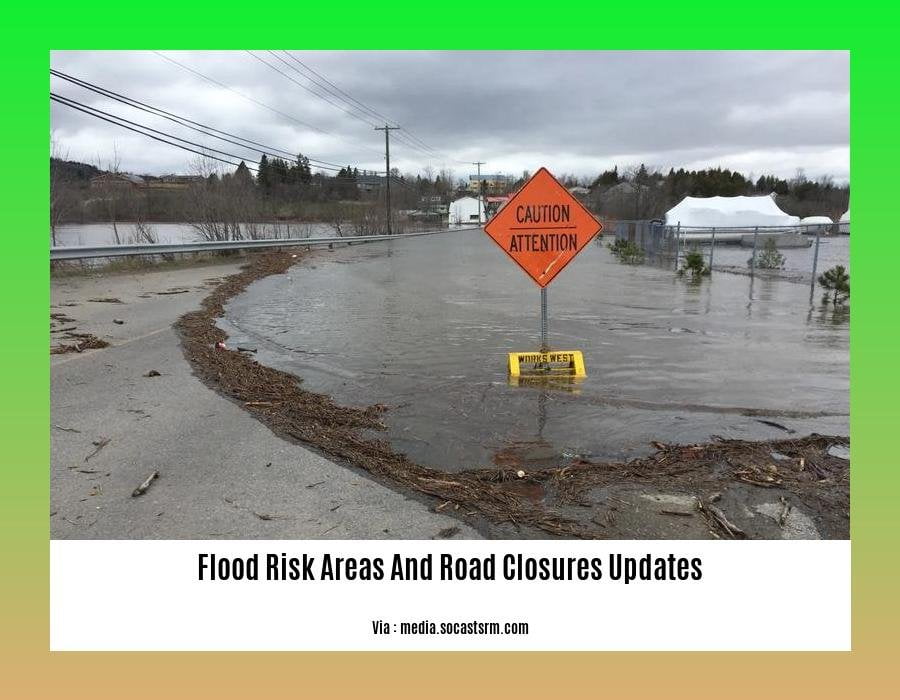**Flood Risk Areas and Road Closures Updates: Stay Informed and Prepared**

Key Takeaways:
- Flood maps identify areas with high flood risk.
- FEMA updates flood maps based on data and risk assessment.
- Flood maps provide information on flood hazards and potential impacts.
- The Risk Map tool can help identify flood risks and reduce property damage.
- Flood maps are crucial for floodplain management and insurance purposes.
Flood Risk Areas and Road Closures Updates: Be Informed, Be Prepared
Flood risk areas and road closures updates are crucial for community safety and preparedness. Knowing where flood risks lie and which roads are impassable can help you make informed decisions to protect yourself and your property.
By utilizing flood maps, you can identify flood risk areas. These maps, maintained by FEMA, provide detailed information on flood hazards and potential impacts. By understanding your flood risk, you can take steps to mitigate it, such as elevating your home or purchasing flood insurance.
Timely road closure updates are equally important. When roads are closed due to flooding or other hazards, it’s essential to know alternate routes to avoid delays and ensure safety. Stay informed by checking official traffic updates and following local authorities on social media.
Remember, staying informed and prepared is key. Utilize available resources like flood maps and road closure updates to minimize risks and ensure your well-being in the face of potential flooding events.
Want to know more about the stages of river flooding? Check out our river flood stage levels explanation page for more information. You can also find out more about street flooding and high water crossing dangers here. For details on flood gauge monitoring and crest forecasting, click here.
What is the National Flood Insurance Program?
The National Flood Insurance Program (NFIP), run by FEMA, is a federal program that enables property owners in participating communities to purchase flood insurance.
Flooding can inflict substantial destruction, with even an inch of water potentially resulting in $25,000 in damages. NFIP helps property owners financially recover from flood-related losses. To assess flood risks, FEMA collaborates with communities to create flood maps, which pinpoint high-risk zones.
FEMA is currently modernizing NFIP’s risk rating system (Risk Rating 2.0) to more accurately reflect individual flood risks, fostering fairer and more equitable flood insurance rates. Additionally, the NFIP Affordability Framework is dedicated to making flood insurance more accessible for policyholders.
Key Takeaways:
* NFIP offers flood insurance through partnerships with insurance companies.
* Flood maps identify high-risk flood areas.
* Risk Rating 2.0 aims to ensure fairer flood insurance pricing.
* The NFIP Affordability Framework promotes affordability for policyholders.
Most Relevant URL Source:
How to View and Obtain Flood Maps
Understanding flood risks and taking the necessary precautions can help protect your property and ensure safety during flooding. Flood maps are essential tools for identifying flood-prone areas and implementing appropriate mitigation measures. Here’s how you can view and obtain flood maps:
Key Takeaways:
- Flood maps guide communities in identifying areas at risk of flooding.
- FEMA’s Flood Map Service Center provides official flood hazard information.
- The National Flood Hazard Layer offers a comprehensive database of flood maps.
- USGS also provides flood maps and flood-related data.
How to View and Obtain Flood Maps:
- Visit the FEMA Flood Map Service Center: Access a searchable database of flood maps for your specific location.
- Utilize the National Flood Hazard Layer: Explore a nationwide database of flood maps through the FEMA GeoPlatform.
- Contact your local floodplain manager: Obtain flood maps and related information from your local authorities.
- Consult USGS resources: Utilize flood maps and data available through the USGS website.
By accessing flood maps, you can gain insights into flood risks in your area. This information is critical for developing flood protection plans, evaluating property, and making informed decisions regarding flood insurance. Stay informed and prepared by staying updated with the latest flood maps.
Most Relevant URL Source:











